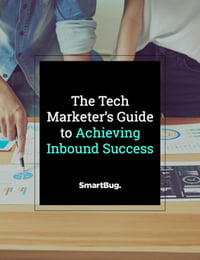
Inbound Marketing for Genomics Companies
September 10, 2019
The modern era of genetics was arguably kicked off when Watson and Crick discovered the DNA double-helix in 1953, but who would have thought that exactly 50 years later, we would have fully sequenced the first human genome when the Human Genome Project announced its completion in 2003. From there, the study of genetics increased exponentially across the country.
In 2012, DNA testing and the implications of one’s genetics got the public’s attention with the launch of AncestryDNA and an aggressive marketing campaign by 23andMe. Today, most individuals in the U.S. have heard of at least one type of genetic testing company, if not tried one as a consumer.
Yet, genetic testing is still in the early phase of adoption and application. For example, 23andMe was not allowed to give users information on genetic predisposition to diseases until 2017 (two years ago!) and pharmacogenomics until 2018.
On the medical side, genetic testing is often not covered by insurance companies, and reimbursement is an ongoing issue with doctors reluctant to recommend tests that they aren’t sure insurance companies will cover (regardless of medical benefit), labs going out of business due to nonpayment, and frustrated patients who know there is a test that could help them.
Most of those in the field envision a future where DNA is collected at birth and kept on a person’s medical file through their life, something that was once considered science fiction. We’re not there yet, but it could be around the corner.
What does all of this mean for genomics companies today? Given the nascent state of the industry, what are some actionable takeaways for using inbound marketing to grow your audience and turn that audience into customers?
Here are the most critical pieces of information that I took away from working with genomics companies for almost a decade.
Be Clear About Your Goals
My personal introduction to genetics came through my time at a company that produces software for statistically analyzing genetic data, targeted to academic institutions for research purposes.
We had a lot of goals for a small company: grow revenue, increase the lead-to-opportunity rate, bring in more leads, get press, become thought leaders, and the list went on. If I could go back in time, I would tell my younger self to focus on one or two goals, not all of them at once.
Your marketing efforts will naturally flow from your main goal. If your goal is to sell the company, press may be a key tactic. If you can’t wait 12 months for leads while inbound marketing gets up and going, you may need to invest in PPC or paid social.
The uncertainty in the marketplace is not a green light for your company to try everything and do it all at once. Take baby steps and focus on one achievable goal at a time.

Diversify—and Do So Strategically
Which brings me to my next point: Don’t put all of your eggs in one basket, but don’t spread yourself too thin when it comes to your product.
The genomics market is still in a growth phase and, thus, changing constantly. If your product is solely attached to one type of sequencing technology, one type of platform, or one partner, you are taking a risky gamble.
The second genomics company I worked for learned this the hard way when they decided to only make the product available on heavy-duty hardware that had to be purchased with the software. They were bought at a fire-sale price a year after their last round of funding.
On the flip side, you cannot be everything to everyone, and you cannot do it all. Most genomics companies have a small engineering staff and budget, which means you have to strategically focus.
What is your product today, what will it be tomorrow, and then what will it be in 10 years? I guarantee you cannot be the next 23andMe and the premier platform for doctors across the country. Choose one vision and work toward diversifying your product for that one vision.
Like All Industries, Personas Are the Foundation
With that specific focus in mind, you have a targeted audience. SmartBug talks about personas all the time, so I’ll direct you to The Ultimate Guide to Inbound Marketing Personas to learn about what they are and why they matter.
But here’s the bottom line: If you don’t strategically diversify, you will have to create a bajillion different personas to appeal to every market you are trying to pursue: one for the consumer, one for the researcher, one for the academic, one for the doctor, one for the clinician, one for the patient, and the list goes on.
So focus: Which two, maybe three, personas are you going to target now?
Personas provide the foundation for all inbound marketing so don’t skip this step and rely solely on the information in your head. Do the legwork to get the most benefit from your inbound marketing efforts.
Depth and Type of Content
Your personas will dictate the type and depth of your content. Consumers (a.k.a., the public) will need clear, concise language in all content. Academics, however, will require from you a level of in-depth knowledge and technical know-how to prove that your organization knows its stuff.
Similarly, the type of content you invest in will also be determined by your audience. While research-focused individuals are used to reading in-depth academic journals that rival the length of a Tolkien novel, patients may respond better to videos.
Pro tip: Given the academic foundation of genetics, educational webinars work really well in this space. Webinars typically have a registrant-to-attendee rate of about three to one, but in the life sciences industry, my experience has been consistently 50 percent and even 60 percent.
Marketing and Sales Alignment Is Vital
This is not new information, but it is worth repeating: If your marketing and sales aren’t aligned, one department or the other is wasting its time. If marketing is giving leads to sales that sales says are no good, marketing needs to change. If sales isn’t following up on leads that both departments have determined are good, then your sales process has to change.
This is especially true in small companies where resources are limited, but genomics companies take this pressure to a new level because of the industry turmoil. If the market shifts, your organization needs to be prepared to adapt. If your marketing and sales are in lockstep, adaptation can be seamless. When the two departments aren’t aligned, the risk to the company is high.
--
Inbound marketing in an emerging market can be a difficult proposition. By keeping your eye on a clear-cut goal, focusing your product strategically, targeting your products, selecting and executing the right content, and making sure sales and marketing are on the same page, you can ensure your genomics company is headed down the right path.

About the author
Jessica Vionas-Singer was formerly the Senior Director of Client Success at SmartBug Media where she lead a team of SmartBugs who focus on HubSpot onboarding for clients new to the system and other project-based work, oversaw new employee onboarding, and rolled out new process and procedures within the Client Services department. She fell in love with marketing at her first job at a technology company specializing in credit evaluation software. Her background includes more than 20 years of marketing experience in content creation and lead-driving tactics, online presence and blog creation, social media engagement, budgeting and project plans, webinar and trade show event management, public relations, comprehensive promotional campaigns, and analytics. Jessica has a BS in Sociology from Montana State University – Bozeman. Read more articles by Jessica Vionas-Singer.




















